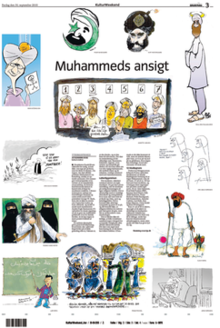Inspired by a Danish Cartoon
Call it a brilliant copycat-motivated manoeuvre, but it worked exceedingly well. At the same time that it illustrated that what was so dreadfully offensive to Muslims was merely a wry reflection of truth-in-hypocrisy. The bomb set to go off in the turban caricatured the fact of violent jihad posing itself as doing the work of Islam at the behest of Koranic texts. The controversial cartoons of Muhammad, as they were first published in Jyllands-Posten in September 2005 (English version). The headline, "Muhammeds ansigt", means "The face of Muhammad".
The controversial cartoons of Muhammad, as they were first published in Jyllands-Posten in September 2005 (English version). The headline, "Muhammeds ansigt", means "The face of Muhammad".Well, just as art imitates life, life imitates art. Flawlessly, to boot. Aren't humans clever? Of course primates are, too. And it's usually monkeys we attribute the 'monkey see, monkey do' vaudeville acts to. But the cartoon, while inspiring a young man to forego his future in favour of a suicide attack by placing explosives within his turban, in Kandahar, has been vindicated by his act.
The cartoon that had been the source of such violent anger and accompanying vicious protests against the West, leading to a number of riots and deaths, elicited rage from the faithful, quite predictably perhaps. But when such dreadful acts are performed by a Muslim the ardour of anger is much diminished and a hushed quiet seems to descend.
Amazement that a faithful Muslim would so insult his own faith. And the belief that somehow, the West must have been responsible for provoking him to such sacrilege. When the very hint of a suggestion is received that someone in the West plans to burn a Koran, the outrage is deafening and viral. But a young Muslim who has dedicated his life as a sacrifice for the greater glory of Islam, while in the process defiling Islam, is barely condemned.
The memorial services for Ahmed Wali Karzai who had been assassinated several days earlier was rocked by an explosion hidden in the turban of a young man whose fervid resolve to martyr himself was granted. How was he persuaded that he would greatly please Allah by sitting beside Maulavi Hekmatullah Hekmat, head of Kandahar's clerical council, and killing him too in the blast?
What faultless logic convinced the young man to fantasize that the Prophet Mohammad would have approved of his defiling a mosque with an explosive hidden in his turban with the intention of blowing innocent people to strips and rags of bloody flesh and entrails, and the Korans they held to blood-soaked ribbons, earning him a beguiling covey of willing virgin flesh in Paradise?
In this young assassin's tradition and heritage a turban itself is considered to be sacred. What this young man performed in the name of scholarly religious pursuits was termed a "violation of the code of the Pashtunwali". "You cannot touch (a turban) because we respect the turban in our culture. These people (the bomber) are misusing its dignity and honour."
Dignity, honour, sacred beliefs, traditions, the tragedy of fundamentalist insanity, all encapsulated in a tribal-based religion that holds life so dear that all are deemed enemies ripe for death. Is that paradox not worthy of a cleverly sly cartoon?
Labels: Afghanistan, Islam, Terrorism, Traditions

<< Home